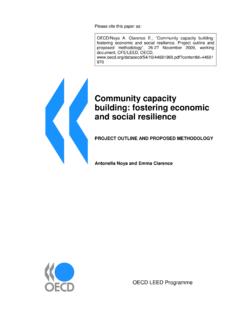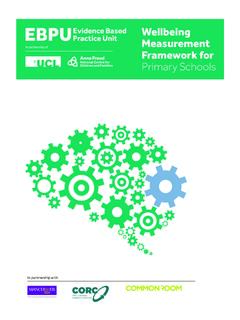Transcription of Coffee Farming and Climate - Royal Botanic Gardens, Kew
1 ECFF. Environment & Coffee Forest Forum Coffee Farming and Climate Change in Ethiopia Impacts, Forecasts, resilience and Opportunities Summary Report 2017. The Strategic Climate Institutions Programme (SCIP). The SCIP Fund was designed to build Ethiopia's capacity to cope with Climate change across the public, private and civil society sectors and to respond to the challenges of transitioning to a Climate Resilient Green Economy (CRGE). Building a Climate -resilient Coffee economy for Ethiopia A two-year SCIP project undertaken by the Royal Botanic Gardens, Kew, and the Environment and Coffee Forest Forum (ECFF), and partners. The aim of the project was to provide a Climate -resilient Coffee economy strategy for Ethiopia, based on a rigorous assessment of the influence of Climate change on Coffee -producing areas and wild Coffee forests. The Climate resilient strategy was developed in close partnership with stakeholders, including government and non-government bodies, Coffee producers and industry.
2 A summary of the strategy is presented here as the report Coffee Farming and Climate Change in Ethiopia Impacts, Forecasts, resilience and Opportunities. Front and back cover picture: Sorting Coffee by hand Leaves of Arabica Coffee Coffee Farming and Climate Change in Ethiopia: Key messages 1. The Coffee growing landscape of 2. The Climate of Africa and Ethiopia Ethiopia is varied and complex has changed and will continue to Coffee Farming in Ethiopia takes place over a change throughout this century vast area, under a wide variety of production The Climate of Africa and Ethiopia has systems and various growing conditions, changed. Ethiopia has experienced an with many different cultivation practices. increase in temperature of around C per decade, and in some areas a reduction in rainfall, since at least the 1950s. 3. Coffee growing in Ethiopia has been 4. Climate change will continue to negatively influenced by Climate impact and alter Coffee growing in change and deforestation Ethiopia over the coming decades Feedback from Coffee Farming communities, Many areas that are suitable for Coffee and observations on Coffee production and growing in the present day will become less Coffee plant stress, indicate that Climate suitable in the future, and in some cases change has already had a negative impact.
3 Unsuitable. Conversely, substantial areas In some Coffee areas, there has been that were previously unsuitable for Coffee dramatic forest loss. Farming will become suitable. 5. Relocation of Coffee farms/areas 6. Appropriate adaptation measures will be a key component in building could ensure resilience for many resilience for the Ethiopian Coffee Coffee farmers economy On-farm adaptation and improvements Many higher altitude areas will become more in Coffee Farming practices could ensure suitable for Coffee production throughout resilience for many farmers. this century. Migration to these areas will be vital for ensuring resilience in the Ethiopian Coffee sector. 1. Fruits of Arabica Coffee , ripening 2. Contents The Coffee growing landscape of Ethiopia 6. is varied and complex Coffee growing in Ethiopia 6. Coffee consumption in Ethiopia 6. Coffee Farming systems 6. Coffee producing regions and areas 8. Overview of Ethiopia's Coffee growing Climate 10.
4 Africa and Ethiopia's Climate has changed 13. and will continue to change Observed changes 13. Predicted future change 16. Coffee growing in Ethiopia has been negatively 20. influenced by Climate change Present-day suitability for Coffee growing in Ethiopia 20. Feedback from Coffee farmers and direct observation 21. Climate change will continue to impact 24. and alter Coffee growing in Ethiopia over the coming decades Climate change modelling for Coffee production 24. in Ethiopia. 1960 to 2099. Relocation of Coffee farms/areas will be 30. a key component in building resilience for the Ethiopian Coffee economy Appropriate adaptation measures could 31. ensure resilience for many Coffee farmers Main recommendations 32. References 33. Endnotes 35. Overview of methods 36. 3. Coffee Farming and Climate Change in Ethiopia Introduction 4. 1. The Coffee growing landscape of Ethiopia is varied and complex 2. Africa and Ethiopia's Climate has changed and will continue to change Sorting Coffee by hand 5.
5 1. The Coffee growing landscape of Ethiopia is varied and complex Coffee growing in Ethiopia Coffee consumption in Ethiopia In its wild state, Arabica Coffee (Coffea arabica) is Ethiopia is unique among the world's Coffee a forest plant restricted to the highlands of Ethiopia producing countries in that around 50% of the Coffee and a small area in neighbouring South Sudan[1]. It it produces stays within the domestic market, for has been used in Ethiopia as a food and beverage consumption by Ethiopians. Drinking is not just for many hundreds, if not thousands, of years. Thus, part of everyday life, it is also deeply embedded Ethiopia can be considered as the biological and in Ethiopian culture. Apart from the well-known cultural home of Coffee . Its early use was no doubt Ethiopian Coffee ceremony, Coffee is used at major restricted to gathering fruits from the wild forests, with events such as marriage and birth, regionally-specific semi-domestication possibly coming soon afterwards.
6 Celebrations, and as a medium to build and sustain Today, an estimated 525,000 hectares (5,250 km2) relationships between family, friends and community. of Coffee are planted in Ethiopia[2], although the actual area is probably in excess of 20,000 km2. Coffee Coffee Farming systems provides Ethiopia with its most important agricultural Ethiopian Coffee is mainly grown under the shade of commodity, contributing around one quarter of its trees (shade or forest Coffee ), either within forest total export earnings[3]. In 2014/15 Ethiopia exported or forest-like environments, or in Farming systems around 180,000 metric tonnes of Coffee [4] at a that incorporate specific shade plants usually value estimated to be in excess of 800 million USD. indigenous (native) trees, or sometimes fruit trees Ethiopia is Africa's largest Coffee producer and the and other crop plants. In some areas Coffee is world's fifth largest exporter of Arabica Coffee [4], grown with little or no shade (sun Coffee ).
7 Forest even though yields (kg/hectare) are low compared (shade) Coffee and sun Coffee can be considered to other producing countries. Coffee Farming alone as the two main Coffee production systems in provides a livelihood income for around 15 million Ethiopia. Irrigation is confined to few locations, Ethiopians (16% of the population), based on four and mostly where water is easily available and can million smallholder farms [2, 3, 5]. For many of these be diverted to the farm using simple means ( farmers, Coffee is their single most important diversion from rivers using trenches). Irrigation is source of income. mainly practiced in Amhara and Benishangul-Gumuz Regions, and the north east part of Oromia Ethiopia is the main storehouse of genetic diversity for Region in the Harar Coffee zone (See Figure Arabica Coffee , and this has several key implications. 1, Table 1). The use of chemical inputs, such For the Coffee sector and consumers, the most as pesticides, fungicides and artificial fertilisers notable of these is the broad diversity of flavour is rarely practiced, and although certification is profiles exhibited by Ethiopian coffees.
8 These profiles not common[5], Ethiopian Coffee can often be are associated with geographical location (which is considered as organic by default, and may indeed often referred to as origin', in a similar way as terroir'. exceed the standards set for organic certification. is used in the wine industry) and factors associated with harvesting and processing. Included among these origins are the well-known coffees of Sidamo, Yirgacheffe, Harar, Nekemte and Limu, but there are numerous lesser-known Coffee regions that have Coffee Farming alone provides a equally distinct flavour profiles. The range of flavour livelihood income for around 15 million profiles adds a unique element to Ethiopian Coffee , and makes it especially well-suited to development Ethiopians (16% of the population), within the speciality Coffee market. As we will see based on four million smallholder farms. below, Ethiopian Coffee production offers protection for biodiversity and other environmental benefits.
9 6. Forest (shade) Coffee can be divided into two broad categories: forest Coffee and semi-forest Coffee . The forest Coffee system uses wild stands of Coffee , which exist naturally within the forest, and the farmer undertakes minimal management and intervention. Semi-forest Coffee is more intensive, with increased Farming interventions ( thinning of trees, understory clearance and weed cutting, and planting of Coffee seedlings). Sun Coffee Farming systems are usually small and mostly fall into the category of Coffee gardens, which are planted in a regular-sized plot at high density. Sun Coffee is usually found at higher altitudes (1700 2100 m), often near dwellings, and is characteristic of Coffee Farming in the Harar Coffee zone. Coffee gardens are often planted close to dwellings and range from a few plants up to a plot of around 100 plants. Coffee gardens are usually part of a mixed cropping system and provide Coffee for the household, local consumption or the wider market.
10 Coffee gardens are planted in either shade or sun. Agroforestry systems are typically family run, of between a quarter and one hectare, and comprise a wide variety of crops in association with indigenous (native) forest cover. The Coffee is usually grown under the shade of indigenous trees with other crops on the margins, or in more open places. In the Sidamo area (including Yirgacheffe), Coffee is almost exclusively produced within an intensively-managed agroforestry system. Coffee farms/plots are dedicated to Coffee growing for profit, and are typically around one to two hectares, sometimes less (a quarter hectare) or more (five hectares). The area is mostly dedicated to Coffee growing, with few other crops, or may be intercropped, as in agroforestry systems. Most Coffee farms use shade, provided by tree cover, but some are situated in partial to full sun. Coffee plantations are large and intensively-managed systems, mostly planted within forest (shade).





